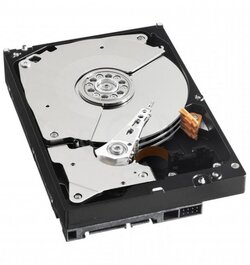Alaric
New Member
- Joined
- Dec 4, 2011
- Location
- Satan's Colon, US
Not Seagate , apparently. https://www.yahoo.com/tech/seagate-faced-class-action-lawsuit-193453745.html
Welcome to Overclockers Forums! Join us to reply in threads, receive reduced ads, and to customize your site experience!
Just gonna leave this here...
https://www.backblaze.com/blog/hard-drive-reliability-stats-for-q2-2015/
Looking at that data makes me wonder if the 3TB drives arent just failed 4TB or largers drives? Is this an acceptable/known practice in HDD as it is in CPU manufacturing? Clearly there was some problem that plagued the 3TB drives in particular, in more than just Seagate.
Yeah Seagate just makes terrible drives. Really don't see any reason to ever buy one over a WD unless you're really broke or something.
but then it was designed with RAID in mind so maybe was more robust on the drawing board.
HDDs are not like CPUs where they are 'binned' lower. In fact they are not remotely associated how that works. One is a piece of silicon with thresholds, while a HDD, let's say a 4TB, it may have 4 1TB platters in it... the 3 TB would then have, 3 1TB platters, They would not leave the last platter in there if it did not work, and make it a 3 TB drive.Looking at that data makes me wonder if the 3TB drives arent just failed 4TB or largers drives? Is this an acceptable/known practice in HDD as it is in CPU manufacturing? Clearly there was some problem that plagued the 3TB drives in particular, in more than just Seagate.
Just gonna leave this here...
https://www.backblaze.com/blog/hard-drive-reliability-stats-for-q2-2015/

Hard Drives:
Article posted on May 10th 2013:
Average Failure rates:
- Toshiba 1,15%
- Seagate 1,44% (vs 1,65%)
- Western 1,55% (vs 1,44%)
- Samsung 2,24% (vs 1,30%)
- Hitachi 2,40% (vs 3,45%)
We mixed all formats of hard drives, which means that we were able to add Toshiba to the list despite a rather small amount of 3.5" drives they sold. This Former arrives in 1st position. Of note is the high failure rate jump for Samsung, compared to the lowering in failure for Hitachi.
Here are the 5 discs with the highest failure rates:
- 5,04% WD Caviar Black 1,5 TB (WD1502FAEX)
- 4,94% Hitachi 7K1000.C 1 TB (HDS721010CLA332)
- 4,87% Hitachi 7K3000 2 ToB(HDS723020BLA642)
- 3,57% Seagate Barracuda 320 GB (ST320DM001)
- 3,51% WD Caviar Red 2 TB (WD20EFRX)
If we look specifically at 2 TB drives here are the obtained numbers :
- 4,87% Hitachi 7K3000 (HDS723020BLA642)
- 3,51% WD Caviar Red (WD20EFRX)
- 3,01% Samsung SpinPoint F4 (HD201UI)
- 2,12% WD Caviar RE4 (WD2003FYYS)
- 1,97% WD Caviar Black (WD2002FAEX)
- 1,95% Seagate Barracuda 7200.14 (ST2000DM001)
- 1,30% WD Caviar Green (WD20EARX)
- 1,01% WD AV-GP (WD20EURS)
And the 3 TB drives :
- 2,85% WD Caviar Green (WD30EZRX)
- 2,71% Seagate Barracuda 7200.14 (ST3000DM001)
- 1,89% WD Caviar Red (WD30EFRX)
Article posted on October 30th, 2013:
Average Failure rates:
- Seagate 0,95% (vs 1,44% year before)
- Hitachi 1,16% (vs 2,40% year before)
- Western 1,19% (vs 1,55% year before)
- Toshiba 1,54% (vs 1,15% year before)
Hitachi HGST which was for a long time the definite last place, continues to improves its failure rate ever since it's buyout by Western Digital, but that's in large part due to the the sales of it's high capacity hard drives which significantly lowered (>2TB hard drives). Toshiba sees it's rate decrease, while Seagate improves it's rate which allows it first place.
Warning: Unlike others, Toshiba doesn't allow a direct return to the manufacturers (so it's failure rate might actually be considerably lower if it were to allow them)
Only one disk obtains a failure rate higher than 4% during this time period, it's the Seagate constellation ES 2 with a rate of 9.64%. The failure rate is high, however the sample relatively small.
Here are the rates for 2TB hard drives:
- 9,64% Seagate Constellation ES ST2000NM0011
- 3,38% Western Digital Caviar RE4 WD2003FYYS
- 2,36% Seagate Barracuda Green ST2000DL003
- 1,45% Western Digital Caviar Black 2 WD2002FAEX
- 1,45% Western Digital Red WD20EFRX
- 1,38% Seagate SV35 ST2000VX000
- 1,35% Western Digital Green WD20EZRX
- 1,12% Seagate Barracuda 7200.14 ST2000DM001
- 1,09% Western Digital AV-GP WD20EURS
- 0,96% Western Digital Caviar Green WD20EARX
- 0,83% Western Digital RE WD2000FYYZ
And for 3TB hard drives:
- 1,99% Western Digital Red WD30EFRX
- 1,48% Western Digital Green WD30EZRX
- 1,29% Seagate Barracuda 7200.14 ST3000DM001
(I have no idea why the 1TB hard drive statistics were not in the article)
3TB drive numbers were the upper extreme for pretty much everyone except Hitachi. Except for those Barracudas - those are off my list as well now. Motors all from a common manufacturer? 3TB is somehow 'unbalanced' number of plates and kills to motor? Who knows - all I can say for certain is that I would think twice about 3TB from any brand now except Hitachi